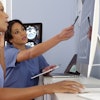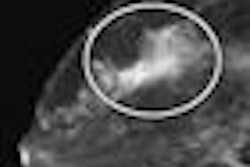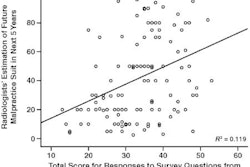Computer-aided detection (CAD) technology yields a high sensitivity in detecting breast cancer on full-field digital mammography (FFDM) images, according to research from Boca Raton Community Hospital in Boca Raton, FL. It also performs well with typically challenging histopathology such as invasive lobular carcinomas and small neoplasms.
"The results of the present study show that the use of a CAD system with FFDM images can mark a high percentage (94%) of breast cancers with an acceptable false-positive rate of 2.3 marks per case," wrote lead author Dr. Juliette The and colleagues in the American Journal of Roentgenology (February 2009, Vol. 192:2, pp. 337-340).
Seeking to evaluate the use of CAD with FFDM images, the researchers studied 123 consecutive biopsy-proven breast cancer cases produced from Boca Raton Community Hospital between March 1, 2005, and February 28, 2006. All mammograms were obtained using a Senographe DS FFDM system (GE Healthcare, Chalfont St. Giles, U.K.). Both screening and diagnostic mammograms were included in the study.
Each case included a craniocaudal (CC) and mediolateral oblique (MLO) view of the breast with cancer at the time of cancer diagnosis; comparable projections including exaggerated craniocaudal lateral, medial lateral, and lateral medial views were acceptable alternatives to CC or MLO views, according to the authors. In all cases, a malignant lesion was visible in at least one view.
Version 7.2 of the SecondLook CAD software (iCAD , Nashua, NH) was applied. The CAD application detected 115 of 123 (94%) cancer cases, including six of six in fatty breasts, 63 of 66 (95%) in breasts containing scattered fibroglandular densities, 43 of 46 (93%) in heterogeneously dense breasts, and three of five (60%) in extremely dense breasts.
It also found 41 of 44 (93%) of cancers manifesting as calcifications, 57 of 62 (92%) of cancers manifesting as masses, and 17 of 17 of those presenting as mixed masses and calcifications.
CAD was also able to detect 94% of the 63 invasive ductal carcinomas, 100% of the seven invasive lobular carcinomas, 91% of the 11 other invasive carcinomas, and 93% of the 42 ductal carcinomas in situ.
"Of particular interest is the finding that sensitivity was maintained in cancers with histopathology traditionally known to lower the sensitivity of mammography (i.e., invasive lobular carcinomas and small neoplasms)," the authors wrote.
CAD also performed well with both small and large lesions, yielding sensitivity of 89% for cancers 1-10 mm (55 cases), 97% for cancers 11-20 mm (37 cases), 100% for cancers 21-30 mm (16 cases), and 93% for cancers larger than 30 mm (15 cases). The average CAD false-positive rate was 2.3 marks per four-image case.
The authors acknowledged limitations of their study, such as the lack of postsurgical follow-up for 16 of the 105 patients included in the false-positive analysis. As a result, marks considered as false positives in those 16 cases could not be confirmed, and a few may actually be true positives, according to the authors.
However, the follow-up data available for the 89 patients resulted in only a 0.02 per case change in the false-positive rate, from 2.30 to 2.28, and no change in the 94% overall CAD sensitivity, they wrote.
"So additional follow-up data for 16 more patients is unlikely to have a significant impact on the reported CAD performance," the group wrote.
The authors concluded that CAD offered high sensitivity with FFDM images and maintained its performance in traditionally challenging histopathology.
"Thus, CAD with FFDM continues to be an effective tool for assisting radiologists with the early detection of breast cancer," the authors concluded. "Future studies are needed to assess the accuracy of CAD in a larger population, including prospective studies in a clinical setting to assess the potential for CAD to reduce radiologist false negatives -- that is, for CAD to help radiologists find more cancers."
By Erik L. Ridley
AuntMinnie.com staff writer
March 4, 2009
Related Reading
Breast MRI CAD algorithm predicts cancer metastasis, February 6, 2009
CAD can boost double-reading detection rate, January 22, 2009
Interactive use of mammo CAD may improve mass detection, December 22, 2008
Breast MRI pinpoints residual disease after chemotherapy, December 19, 2008
New mammo CAD approach lowers false positives, December 2, 2008
Copyright © 2009 AuntMinnie.com




















